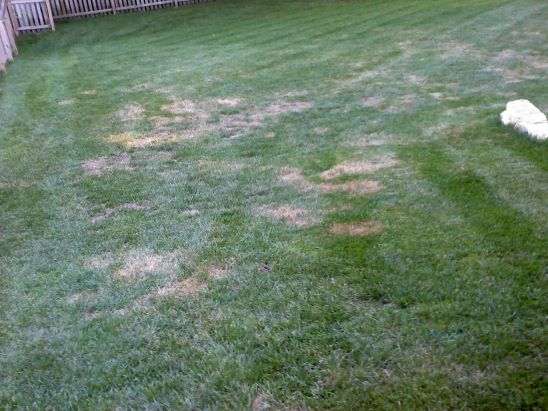Brown Patch
Return to Horticulture Agent Articles

A few years back, when working as a horticulture Extension agent in western Kansas, I was inundated one summer with a flurry of questions about large dead patches of grass in people’s lawns. For those unfamiliar with the western Kansas climate, it is very hot, abhorrently dry, and generally a borderline arid growing environment. Thus, when this inundation of lawn spots began to occur, the first thought to cross my mind was, “Have we even had enough water for it to be a disease?” The answer was yes, we had, and with an extra early-summer shower or two in addition to people overwatering their lawns, Brown Patch was beginning to run rampant across the county.
Here in Kansas City, Brown Spot is a common issue, mainly due to our high relative humidity. In addition to warm summer nights, this keeps grass leaf blades wet longer, enabling the fungal disease to set and spread within lawns. How do you identify it? As the name suggests, you will see a patch of dead brown grass, generally circular in orientation. Looking closer, however, you can also note the presence of the disease by looking at the leaf blades. Here, the fungal infection shows as mottled streaks of dead with red rings around them. Another indication: It typically appears on cool-season lawns, such as tall fescue, bluegrass, and perennial rye.
With the summer heat here and excessive moisture, it seems likely that Brown Patch is raring for its resurgence. Lighter infestations of Brown Patch will typically recover in a turf stand within 2-3 weeks, but for severe infestations, the disease can be a death sentence. To control this, you will first want to look at your lawn care practices.
Avoid prolonged standing water on leaf blades. Watering early before sunrise is the best time to water a lawn. The sun’s rise will evaporate any remaining moisture, preventing fungal spores from rooting or spreading. Additionally, this will give the lawn ample time to absorb the water being applied rather than losing it to evaporation, which is why the practice is recommended outside of disease mitigation. Watering in the evening or at night should be heavily avoided, as this will keep the blades wet the longest –not giving them a chance to dry until morning.
Looking elsewhere, overfertilizing a lawn with excessive nitrogen is a significant factor in developing the disease. In essence, the nitrogen is the fungi’s food source. Depriving it of this source helps keep it in check. So, it’s a tradeoff. Your grass may not be as green as desired, but it will be healthy.
Also, if an infection is severe and treatment is necessary, brown patches can be suppressed by fungicides containing the active ingredients captan, propiconazole, triadmefon, or myclobutanil. Aim for the prevention methods first, though. With mitigation efforts made, the grass will bounce out of it on its own.
Reardon, Small Farms Horticulture Agent, 2024
Other Resources
Have questions? The Garden Hotline is staffed by trained EMG volunteers and Extension staff who will assist you with questions.
Do you need help selecting a tree? Give our Garden Hotline a call (913-715-7050). Email detailed photos with your questions to garden.help@jocogov.org
